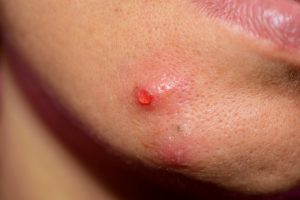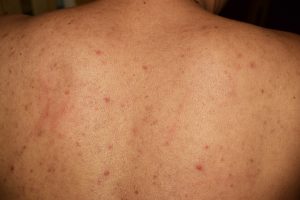What is pregnancy acne?
Pregnancy acne is a common skin concern for many expectant mothers, and for good reason! This annoying condition can cause red, inflamed bumps to appear on the skin, and can be a source of frustration and insecurity for moms-to-be.
Hormonal changes during pregnancy can lead to an increase in oil production, which can cause acne to flare up or worsen. Additionally, the use of certain medications and skincare products may be limited during pregnancy, making it difficult to treat acne effectively. In this article, we will discuss the causes of pregnancy-related acne, how it can be managed, and safe treatment options.

One of the primary causes of acne during pregnancy is an increase in androgen hormones, which stimulate oil production in the skin. These hormones are present in both men and women, but they are present in higher levels in men. Acne often worsens because of large swings in these hormones.
What does pregnancy acne look like?
Pregnancy acne presents with whiteheads and blackheads (comedones), red bumps, pus bumps, and nodules (cysts).
When does pregnancy acne start?
A lot of women who have acne before their pregnancy notice that their acne fluctuates in the first trimester when hormone levels surge before stabilizing in the second and third trimester. Pregnancy acne often worsens right after giving birth (postpartum period), when estrogen levels drop.
Where is pregnancy acne located?
Pregnancy-related acne typically appears on the face, neck, chest, and back, and it can range from mild to severe.

Why is pregnancy acne difficult?
Acne can cause a lot of mental health issues such as depression and anxiety. There are a lot of acne medications on the market, but information about the effects of these medications on the developing fetus and infant is limited. Pregnant and lactating women are usually left out from clinical trials. Most available information on the potential for birth defects of these medications is obtained from cases of accidental exposure, where a woman used the products before she found out she was pregnant.
How to treat acne in pregnancy?
There are several ways to manage pregnancy-related acne and reduce the risk of breakouts. One of the most important is to maintain a consistent skincare routine that includes cleansing, toning, and moisturizing. It is important to choose products that are formulated for acne-prone skin and are safe to use during pregnancy.
Gentle cleansing is key to maintaining healthy skin during pregnancy. It is important to avoid using harsh cleansers or scrubs, as they can strip the skin of its natural oils and exacerbate acne. Instead, opt for a gentle, oil-free cleanser that is formulated for acne-prone skin.
Toning can help to balance the pH of the skin and tighten pores, which can help to reduce the risk of acne. It is important to choose a toner that is alcohol-free, as alcohol can be drying and irritating to the skin.
Moisturizing is an important part of any skincare routine, and it is especially important during pregnancy when hormone levels are fluctuating. Choose a moisturizer that is oil-free and non-comedogenic, meaning it will not clog pores.

In addition to a consistent skincare routine, it is important to maintain a healthy diet and lifestyle during pregnancy. A diet rich in fruits, vegetables, and whole grains can help to support healthy skin, while a diet high in sugary and processed foods can increase the risk of acne. It is also important to stay hydrated by drinking plenty of water, as hydration is key to maintaining healthy skin.
While it is generally safe to use over-the-counter acne medications during pregnancy, it is important to check with a healthcare provider before starting any new treatment. Some acne medications, such as retinoids, are not safe to use during pregnancy and can cause birth defects. Salicylic acid and benzoyl peroxide are two commonly used over the counter acne medications but their safety in pregnancy has been questioned.
Your dermatologist may recommend a prescription medication. It is important to discuss the potential risks and benefits of any medication with a healthcare provider, as some prescription medications may not be safe to use during pregnancy.
Topical Medications
As a general rule, topical agents like creams and gels are safer than oral medications for use in pregnancy and lactation, because bloodstream absorption is minimal. Erythromycin, clindamycin, and metronidazole are antibiotic gels that are generally thought to be safe for use in pregnancy and lactation. Azelaic acid is also thought to be safe in pregnancy. When applied to the skin, absorption is basically zero.
Retinoids are vitamin A based medications and include the very popular Retin-A and over the counter retinol. They are generally NOT considered safe in pregnancy because of risk of birth defects.
Medications by mouth
Erythromycin by mouth has classically been the medication of choice when a strong acne medication is needed during pregnancy. Although mostly safe for use, there have been a few reports of fetal heart and liver problems. Azithromycin is another oral medication that is also safe and effective. Antibiotics like doxycycline and minocycline, which are commonly prescribed to non-pregnant women, should NOT be used in pregnancy because they can cause bone and teeth problems in your developing baby.
Zinc supplementation is a safe and effective way of controlling acne during pregnancy. Studies have consistently proven that at doses below 75 mg/day no harm is posed to the growing baby. Pretty much everything else by mouth is not safe in pregnancy including the commonly prescribed medications isotretinoin (Accutane) and spironolactone. After pregnancy while breastfeeding, an estrogen-containing birth control pill is quite effective, especially if your acne is worsened during your period and the week leading up to it.
So, how can I fix my pregnancy acne?
A suggested regimen for treating your acne during pregnancy and lactation would be: for mild to moderate acne, talk to your My Skin of Color provider about prescribing azelaic acid. Topical antibiotics like clindamycin or erythromycin are also safe. For more severe acne, erythromycin or azithromycin by mouth are safe in pregnancy and lactation. Zinc supplementation is also safe and effective for acne of any severity. Once you give birth, consider starting an estrogen based birth control, which can also help a lot. Of course, talk to your dermatology provider and OB/GYN before making any decisions, because there may be personal factors that would favor the use of one medication over another.

Other general tips for acne in pregnancy include:
- Keep your skin clean: Wash your face twice a day with a gentle, oil-free cleanser. Avoid scrubbing or over-drying your skin, as this can irritate acne and make it worse.
- Use non-comedogenic products: Choose skincare products that are labeled “non-comedogenic,” which means they won’t clog your pores. This can help prevent acne from forming in the first place.
- Moisturize regularly: Pregnancy acne can be exacerbated by dry skin, so make sure to moisturize regularly to keep your skin hydrated. Choose a lightweight, oil-free moisturizer to avoid clogging your pores.
- Avoid picking or squeezing acne: It can be tempting to try and pop your acne, but this can actually make the problem worse. Picking or squeezing acne can lead to scarring and further inflammation, so try to resist the urge.
Pregnancy acne is a common and frustrating problem, but with the right skincare routine and some patience, you can manage it and keep your skin looking healthy and glowing.
Patients located in NY and Florida can start a pregnancy acne consultation by clicking below.

